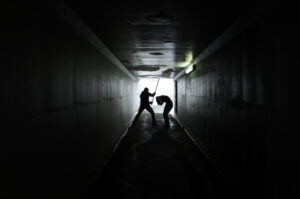Charleston, South Carolina, experienced the most powerful earthquake ever to strike the east coast of the United States. Because of the epicenter’s closeness to the city, damage was extensive in and around Charleston and the quake was felt in places all the way from Canada to the Gulf of Mexico.
Charleston was the scene of a 7.3 strength earthquake on August 31, 1886, the greatest quake to hit the east coast of the United States in historical times. More than a hundred buildings and many thousands of chimneys in the city were destroyed. About sixty people were killed. The reason for the enormous amount of damage to chimneys and the lesser destruction of buildings generally stems from an edict dating back more than forty years following a disastrous city fire. During that fire, older wooden buildings had been burned to the ground so it was mandated that, for all future construction, brick was required. Unfortunately, an inferior type of mortar was used in the construction of many of the newer buildings and, accordingly, these were the buildings that toppled in the August 31 event. This earthquake was felt all the way from Canada to the Gulf of Mexico.
Any earthquake in this part of the nation in and surrounding Charleston, South Carolina, causes damage over an area larger than that influenced by comparable quakes in the West both because of lower bedrock density and because of its location within the continental plate rather than at the area of interaction between two plates. This Charleston event was similar to three events in the eastern and central parts of the United States: the offshore earthquake in Massachusetts in 1755 and the Madrid earthquakes of 1811 and 1812. Overall, the pressures at work were similar for all three of these. The ocean crust moved westward from the Mid-Atlantic Ridge, pushing North America slowly toward Asia and, in doing so, created tensions in the continental lithosphere that caused these major earthquakes as well as numerous minor ones. Pressure from the Juan de FICA Plate as it moves crust in the opposite direction heightened these tensions, slowing the process slightly but not stopping it.
There were numerous aftershocks after the 1886 earthquake and earthquakes will occur again in or near Charleston. Of the over 400 earthquakes reported to have occurred in this area since 1774, most were aftershocks from the 1886 event. Furthermore, recent research revealed evidence of large quakes near Charleston approximately 600 and 1,300 years ago, suggesting that the frequency of these monster quakes may be of the order of every 500 years. After the 1886 quake, people reinforced their buildings with wall anchors that tied walls and roofs to the floor in order to prevent them being blown out in another earthquake. The effectiveness of these measures has yet to be tested and may not be tested in the lifetimes of the next several generations. For the present, there needs to be a change of attitude toward the danger of earthquakes in the eastern part of the continent. The western portion of the continent tends to receive the majority of the attention when it comes to earthquakes because of the frequency and size of the events that occur in that area. Since the 1960s and the deployment of the Global Seismograph Network (GSN) which records small quakes as well as larger ones we now know that a small earthquake strikes somewhere within the regions of Appalachia and the Coastal Plains every day.
In the aftermath of the 1886 earthquake, railroad tracks buckled in a number of locations and telegraph wires were cut, leaving Charleston with no communication links to the rest of the world for a couple of days. Even then, there was no serious lack of food but the means for preparing the food that was available were inadequate since few houses escaped damage and many were totally destroyed. Much of Charleston was built on what was known as “made” land; that is, land formed by filling in existing creeks or extending shorelines with deposits of sand and rock. Older houses stood up better than newer ones because they had employed handmade bricks with a rough surface that were able to maintain a strong bond with mortar. One family that lived in an older house slept through the earthquake without knowing it had occurred. Well-built wooden homes with parts carefully pinned together withstood the shaking as well. These homes had an elastic quality enabling them to stretch under pressure and then return to their original shape.
There were two epicenters for this earthquake, one sixteen miles north of the city and the other thirteen miles to the west. The close proximity of these epicenters to Charleston accounted for so much widespread damage. Summerville, a town of about 2,000 people near the north epicenter, experienced sounds like major explosions on October 27 and 28. When the earthquake struck people in the town were tossed from side to side and frequently thrown to the ground. Houses appeared to be receiving heavy blows from below; chimneys fell down, sometimes carrying fireplaces with them as they collapsed into a heap of rubble. All indications pointed to strong vertical motion. Aftershocks gave a powerful boom sound. Ground fissures were everywhere and from some of them water was extruding, sometimes in the form of jets, at other times mixed with sand. The severity of the earthquake was felt over a much bigger area than the environs of Charleston, albeit in terms of lesser amounts of damage. For an area within eight hundred miles of the city severe shaking was experienced.























1 thought on “Charleston Earthquake – South Carolina – August 31, 1886”
What is the building in the picture?